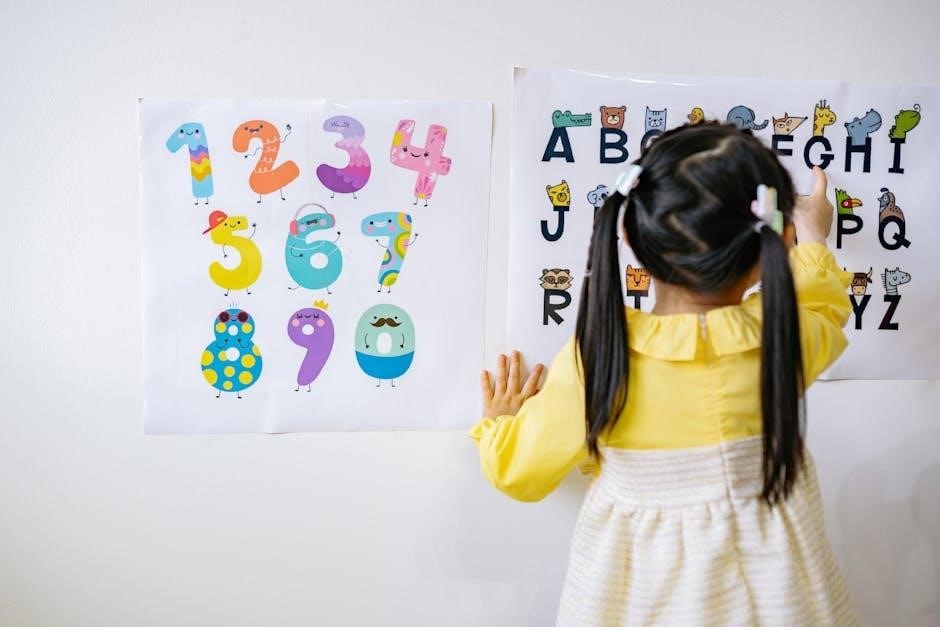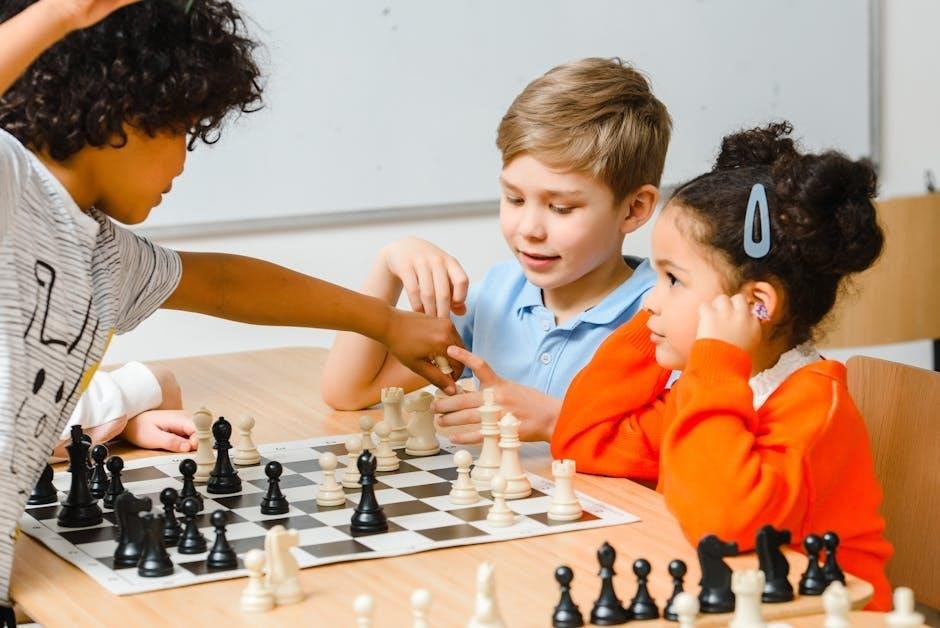The Whole Brain Child concept is introduced by Daniel J Siegel and Tina Payne Bryson in their book‚ providing parents with practical strategies to nurture their child’s developing mind effectively every day.
Understanding the Concept of the Whole Brain Child
The concept of the Whole Brain Child is based on the idea that a child’s brain is composed of different parts‚ including the upstairs brain and the downstairs brain‚ which work together to regulate emotions and behavior.
The upstairs brain is responsible for rational thinking‚ decision-making‚ and problem-solving‚ while the downstairs brain is responsible for emotions‚ instincts‚ and automatic responses.
Understanding how these different parts of the brain interact and influence each other is crucial for parents and caregivers who want to help their children develop emotional regulation‚ social skills‚ and academic success.
By recognizing the interplay between the upstairs and downstairs brain‚ parents can use strategies to integrate their child’s brain‚ promoting healthy development and relationships.
This concept is explored in detail in the book “The Whole Brain Child” by Daniel J Siegel and Tina Payne Bryson‚ which provides practical tips and techniques for parents to support their child’s brain development.
The book offers a comprehensive approach to understanding the Whole Brain Child concept‚ making it an essential resource for parents and caregivers.
The concept has been widely praised for its simplicity and effectiveness in helping children develop emotional regulation and social skills.
Importance of the Whole Brain Child Approach
The Whole Brain Child approach is essential for promoting healthy brain development in children‚ leading to improved emotional regulation‚ social skills‚ and academic performance.
This approach recognizes the critical role of parents and caregivers in shaping a child’s brain development and provides them with practical strategies to support this process.
By using the Whole Brain Child approach‚ parents can help their children develop self-regulation skills‚ manage stress and anxiety‚ and build strong relationships with others.
The approach is also important for helping children develop resilience and adaptability‚ enabling them to navigate challenges and setbacks with confidence and determination.
Furthermore‚ the Whole Brain Child approach can help parents and caregivers create a nurturing and supportive environment that fosters a child’s overall well-being and development.
The importance of this approach lies in its ability to provide parents with a comprehensive and effective framework for promoting healthy brain development and supporting their child’s unique needs and abilities.
The Whole Brain Child approach has been widely recognized as a valuable resource for parents and caregivers seeking to support their child’s development and well-being.

Key Strategies for the Whole Brain Child
Several key strategies are outlined in the Whole Brain Child book to support child development and parenting effectively every day.
Engage Their Upstairs Brain in Problem-Solving
The upstairs brain is responsible for problem-solving‚ and engaging it in this process is crucial for a child’s development. By encouraging children to think critically and come up with their own solutions‚ parents can help strengthen their upstairs brain. This can be achieved by asking open-ended questions‚ providing opportunities for decision-making‚ and encouraging children to reflect on their experiences. The upstairs brain is also involved in emotional regulation‚ and by engaging it in problem-solving‚ children can learn to manage their emotions more effectively. According to the Whole Brain Child approach‚ engaging the upstairs brain in problem-solving can help children develop better social-emotional intelligence and improve their relationships with others. By incorporating this strategy into daily life‚ parents can help their children develop essential life skills and promote healthy brain development. This approach can be applied in various situations‚ from everyday challenges to more complex problems‚ and can have a positive impact on a child’s overall well-being and success.
Use It or Lose It: Exercising the Upstairs Brain
Exercising the upstairs brain is essential for its development and function. The Whole Brain Child approach emphasizes the importance of providing opportunities for children to practice upstairs brain skills‚ such as planning‚ problem-solving‚ and decision-making. By doing so‚ parents can help strengthen their child’s upstairs brain and promote healthy brain development. This can be achieved through various activities‚ such as puzzles‚ brain teasers‚ and strategy games. Additionally‚ encouraging children to think critically and reflect on their experiences can also help exercise their upstairs brain. The upstairs brain is responsible for many higher-order thinking skills‚ and exercising it regularly can help improve cognitive function and promote social-emotional intelligence. By incorporating upstairs brain exercises into daily life‚ parents can help their children develop essential skills and promote a strong foundation for future success. Regular exercise of the upstairs brain can also help improve emotional regulation and reduce stress.

Practical Applications of the Whole Brain Child
Practical strategies help parents nurture their child’s developing mind effectively every single day always.
Connect and Re-Direct When the Child is Upset
When a child is upset‚ it’s essential to connect with them first‚ using right brain to right brain communication‚ such as loving touch‚ empathy‚ and validation of their feelings. This helps to calm the child down and creates a sense of safety and security. Once the child is more receptive‚ parents can redirect them‚ using left brain strategies‚ to involve the child in making amends and finding a solution to the problem. This approach helps to integrate the child’s brain‚ promoting healthy emotional regulation and social-emotional intelligence. By connecting and re-directing‚ parents can turn a potentially explosive situation into a teaching moment‚ helping their child develop essential life skills‚ such as self-regulation‚ self-awareness‚ and problem-solving. This strategy is a key component of the Whole Brain Child approach‚ which provides parents with practical tools to nurture their child’s developing mind and promote a stronger‚ more loving relationship. Effective connection and re-direction can have a positive impact on the child’s emotional well-being and behavior.
Name It to Tame It: The Power of Labeling Emotions
Labeling emotions is a powerful tool for helping children manage their feelings and develop emotional regulation. By naming their emotions‚ parents can help their child process and understand their feelings‚ reducing the intensity of the emotion and promoting a sense of calm. This strategy‚ known as “Name It to Tame It‚” is a key component of the Whole Brain Child approach‚ which emphasizes the importance of teaching children to recognize‚ express‚ and manage their emotions in a healthy way. When parents label their child’s emotions‚ they help their child develop a vocabulary for their feelings‚ which can help them communicate more effectively and build stronger relationships with others. By acknowledging and validating their child’s emotions‚ parents can create a safe and supportive environment‚ where their child feels heard and understood‚ and can begin to develop the skills they need to manage their emotions and behave in a more positive way. This approach can have a profound impact on a child’s emotional well-being and relationships.

Benefits of the Whole Brain Child Approach

Improves emotional regulation‚ reduces meltdowns‚ and enhances parent-child relationships effectively every day.
Reducing Meltdowns and Improving Emotional Regulation
The Whole Brain Child approach offers practical strategies to reduce meltdowns and improve emotional regulation in children. By understanding how the brain works‚ parents can help their child develop better emotional control. The approach emphasizes the importance of integrating the upstairs and downstairs brain‚ which helps to balance emotions and logic. This integration enables children to manage their emotions more effectively‚ reducing the frequency and intensity of meltdowns. The Whole Brain Child approach also provides parents with tools to help their child develop self-regulation skills‚ such as deep breathing‚ visualization‚ and physical activity. By teaching children these skills‚ parents can help them develop better emotional regulation‚ leading to a more harmonious and balanced family life. The approach is based on the latest research in brain development and provides parents with a comprehensive guide to nurturing their child’s emotional intelligence. Effective emotional regulation is essential for children’s social‚ emotional‚ and academic development.
Improving Parent-Child Relationships
The Whole Brain Child approach focuses on building a strong‚ loving relationship between parents and children. By using the strategies outlined in the book‚ parents can create a more nurturing and supportive environment‚ which helps to foster a deeper connection with their child. This approach encourages parents to be more mindful and present in their interactions with their child‚ leading to a more empathetic and understanding relationship. The Whole Brain Child approach also helps parents to communicate more effectively with their child‚ reducing conflicts and increasing cooperation. By working together and using the strategies outlined in the book‚ parents and children can develop a more positive and loving relationship. This‚ in turn‚ can lead to a more harmonious family life and a stronger bond between parents and children. The approach provides parents with the tools and techniques needed to create a more loving and supportive relationship with their child‚ which is essential for their emotional and social development.
